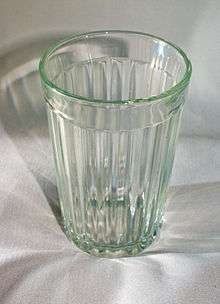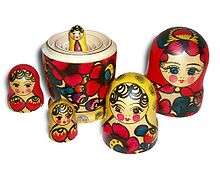Table-glass

Table-glass or granyonyi stakan (Russian: гранёный стакан, literally faceted glass) (Ukrainian: granchak гранчак, derived from грань, meaning facet) is a type of drinkware made from especially hard and thick glass and having a faceted form. It is a very widespread form of drinking glass in Russia and the former Soviet Union. Granyonyi stakan has certain advantages over the other drinkware, since due to its form and hardness it is more difficult to break. It is arguably handier in usage on moving trains or rolling ships, where it is less prone to decline and fall, or slip from hands, and less likely to be broken when hitting the floor, compared to non-faceted types of drinking glasses.
Granyony stakan may be used to drink any type of beverage. It is often used in combination with tea glass-holder (Podstakannik).
The classical form of Russian and Soviet granyonyi stakan is that with 14, 16, 19, or 20 facets; possibly with other values. Such glasses have been produced since 1943 at a factory in the city of Gus-Khrustalny, the famous center of Russian glass-making. According to one theory, this version of drinking glass became a preferred one and was massively produced in the Soviet Union because it was more fit to be washed using dish washing machines. A legend tells that the 14-facets form was designed by a famous Soviet sculptor Vera Mukhina.
.jpg)
Faceted drinking glasses, however, have been known in Russia from much older time. Their depictions are often found on the pictures from the late 19th and early 20th centuries, when they became widespread.
A legend says that the first known faceted glass was given as a present to Tsar Peter the Great from a glass-maker called Yefim Smolin, living in Vladimir Oblast. He boasted to Tsar that his glass couldn’t be broken. Tsar Peter liked the present, however, after drinking some alcoholic beverage from it, he said loudly Let the glass be! (Russian: Стакану быть!), threw the glass on the ground and managed to break it. But Peter didn’t punish the glass-maker, and the production of such glasses continued. According to the legend, people present during this episode misinterpreted the Tsar’s words and thought that Peter called to break the glasses (Russian: Стаканы бить! - literally beat glasses or break glasses), that’s how a tradition of breaking drinkware on certain occasions appeared in Russia. Glasses were broken after especially important toasts or just during the especially cheerful parties. Russian restaurants even held special price lists for breaking the glasses. Breaking of drinkware, or, in wider context, any tableware, is believed in Russia to bring luck and happiness.
The popularity of hard-to-break table-glasses diminished after 1970-s, when more thin-glass drinkware started to be produced using equipment brought from Hungary. Several factories in Russia and Ukraine still produce granyonyi stakans, which became somewhat symbolic of the Soviet era and sometimes perceived as souvenirs.
An image of granyonyi stakan in popular culture is associated either with vodka and pickled cucumbers, or with tea and podstakannik, a metal holder with handle, for the glass.
See also
References
- The Day of Granenyi Stakan at hronograf.narod.ru (Russian)
- Let the stakan be! The history of granyonyi stakan at barmenu.ru (Russian)



